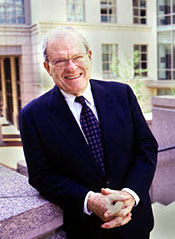F.
Stuart Gulley can remember the precise moment he
hit upon the title for his book about former Emory President
James T. Laney. On the evening after Gulley finished his third
and final one-to-one interview with Laney, U.S. President Bill
Clinton appeared on national television to admit he had misled
the public about his dealings with a White House intern. Gulley
says he was struck by the gulf of difference between leading
by vocation and leading by moral example. He called his book
The Academic President As Moral Leader.
“Laney,
more than any research university president of his era, believed
that an academic president was fundamentally a moral leader,”
Gulley writes in his introduction. “The moral authority
of the president, for Laney, derived from the fact that a liberal
arts education in and of itself was a moral endeavor. Thus .
. . the president was to demonstrate those qualities of moral
leadership that would have a leavening effect throughout the
institution.”
Published
last year, The Academic President As Moral Leader traces
the arc of Laney’s presidency from 1977 to 1993, the period
of Emory’s breathless climb from respected regional institution
to major research university.  But
as the title suggests, Gulley’s account is more than the
story of Emory’s and, by extension, its president’s
success; it is rather a thoughtful examination of how Laney
(left) infused his leadership with a deliberate moral and ethical
consciousness and balanced the University’s fortune with
vision.
But
as the title suggests, Gulley’s account is more than the
story of Emory’s and, by extension, its president’s
success; it is rather a thoughtful examination of how Laney
(left) infused his leadership with a deliberate moral and ethical
consciousness and balanced the University’s fortune with
vision.
Gulley
spent ten years at Emory, the first seven of which coincided
with Laney’s presidency. He earned his Master’s of
Divinity in 1986 and then rose to the position of associate
vice president for university development and church relations
before he left in 1996 to become president of LaGrange College.
In
examining the whole of Laney’s tenure, Gulley concludes
that his leadership–and its legacy–shaped Emory in
ways that can’t easily be explained by simply listing Laney’s
various strengths and chronicling his triumphs. Some of his
most identifiable assets, Gulley observes, were his vision,
clear-headed ambition, passionate devotion to the liberal arts,
dogged determination, and ability to tolerate the ambiguity
that often characterizes the university culture.
Gulley
credits Laney’s oft-stated moral vision for Emory with
the event that had perhaps the greatest impact on his presidency,
the 1979 Woodruff gift of an unprecedented $105 million. Spurred
by his desire for excellence, Laney purposefully nurtured his
friendship with Robert W. Woodruff and his brother, George,
an alliance that resulted in what was then the largest philanthropic
gift ever made to an American university.
“Jim
carefully cultivated the Woodruff interest in the University,
and he did it in a way that focused on the total University
and not just the health sciences, which had been their primary
interest,” Gulley says. “This enabled a lot of things
that could not otherwise have been done.”
With
riches came responsibility, and Laney was constantly challenged
to balance his drive for success with his steadfast integrity,
Gulley says. For example, he never allowed money to be spent
on improvements at Lullwater beyond what was strictly necessary,
lest he give the impression that he was using Emory’s fortune
for personal gain. But he used salaries to attract desirable
faculty from other universities.
At
a reception hosted by the Candler School of Theology to celebrate
the book, Laney expressed gratitude for Gulley’s recognition
of his efforts. He grew emotional when he spoke of the support
he received from others, in particular his wife, Berta. “I
have to say that from my high school years on,” Laney said,
“there was one true North, and one true love.”
“A
University is a unique thing, an incredible organism, with all
its pursuits, intricacies, and involvements,” Laney went
on. “But what really goes on is sharing from one generation
to another. You have laboratories, sophisticated libraries,
computers, all these things that mark modern life. . . .But
the University is really that juncture from past to future.
And that juncture has to be marked by what we care about, what
we value, as well as by what we know.”–P.P.P.